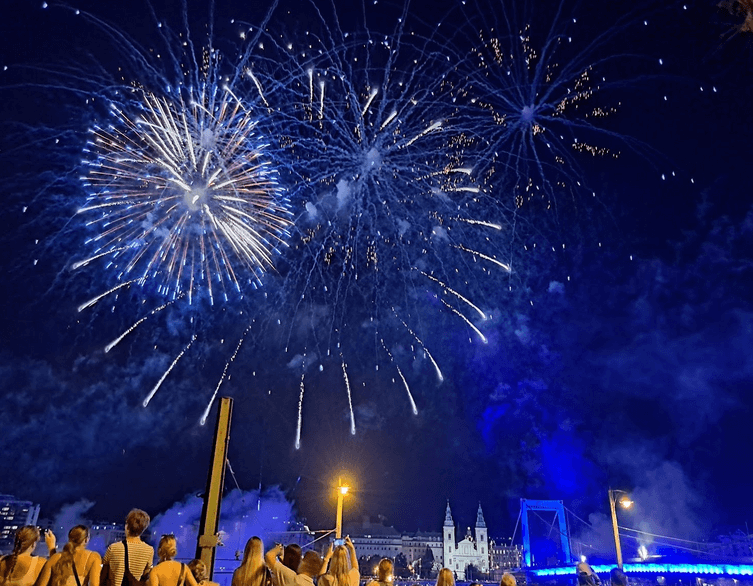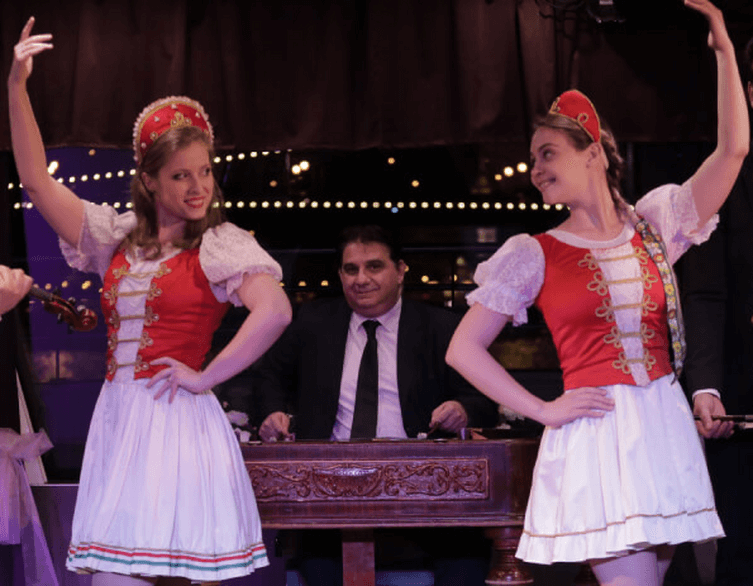Budapest’s Grand Fireworks Spectacle: When Celebration Meets Reality

When you visit Budapest in late August, you might witness one of Europe’s most spectacular yet contentious public celebrations. The Saint Stephen’s Day fireworks display over the Danube River represents far more than just a beautiful light show – it’s a window into Hungarian society, politics, and the complex relationship between tradition and modern realities.
The Spectacle That Captivates a Nation
Picture this: you’re standing along the Danube embankment, surrounded by hundreds of thousands of fellow spectators, as the summer evening sky erupts in brilliant colors above Budapest’s iconic Parliament building and Chain Bridge. The pyrotechnics reflect off the river’s surface, creating a doubled display that photographers and tourists alike scramble to capture. This is Saint Stephen’s Day, Hungary’s national holiday celebrating the founding of the Hungarian state over a thousand years ago.
The scale of this celebration is truly breathtaking. What unfolds before your eyes represents one of the most expensive single-day public celebrations in all of Europe. The fireworks alone cost an astounding 3.6 billion Hungarian forints, while the entire day’s festivities command a budget exceeding 14.5 billion forints when all associated costs are calculated. To put this in perspective for international visitors, this represents roughly the same as some small European cities’ entire annual cultural budgets.
The logistics behind creating this spectacle are equally impressive. Lounge Event Ltd., owned by Balásy Gyula, orchestrates this massive undertaking, coordinating everything from pyrotechnics launched from multiple points along the river to crowd control for the hundreds of thousands who gather to watch. The complexity of staging such an event in a historic city center, with its narrow medieval streets and protected architectural heritage, cannot be understated.
The Morning After Reality
What most tourists never see is the remarkable transformation that occurs in the hours immediately following the celebration. As the final firework fades and the crowds begin to disperse from both sides of the Danube, an entirely different kind of spectacle begins to unfold – one that reveals the hidden machinery that keeps Budapest functioning.
The moment the last spectator leaves the embankments, 105 dedicated workers from the FKF Public Cleaning Division of Budapest Public Utilities spring into action. Armed with 21 specialized cleaning vehicles and an almost military-like precision, they begin the monumental task of restoring the city to its pristine condition. This operation continues through the night and well into the following day, ensuring that by the time morning coffee shops open their doors, visitors would never guess that hundreds of thousands of people had gathered here just hours before.
The scale of this cleanup operation tells its own story about modern urban celebrations. These dedicated workers collect and remove over 12 tons of waste from the celebration areas. To clean the streets properly, they use nearly 250,000 liters of water, washing away not just the obvious debris but also the more subtle traces of such a massive gathering – from spilled drinks to the fine dust kicked up by hundreds of thousands of footsteps.
This cleanup extends far beyond the main viewing areas along the Pest and Buda embankments. The workers methodically clean the Danube bridges, which serve as prime viewing locations, and all the surrounding city areas that become part of the celebration zone. They empty overflowing waste bins, sweep up debris that has been trampled into the historic cobblestones, and ensure that Budapest’s famous cleanliness standards are maintained.
A Nation Divided by Tradition
What makes Budapest’s Saint Stephen’s Day celebration particularly fascinating for foreign visitors is how it reflects deeper currents in Hungarian society. This isn’t simply a case of unanimous national pride expressing itself through spectacular celebration. Instead, the event has become a lens through which to examine contemporary Hungarian values, priorities, and political divisions.
Recent polling reveals a surprising complexity in how Hungarians view their own national celebration. According to research by Publicus, 61 percent of Hungarians don’t actually consider the annual grand fireworks display a positive tradition for celebrating their nation’s founding. Only 35 percent support this spectacular and admittedly noisy form of celebration, though this figure jumps dramatically to 72 percent among supporters of the governing party.
This division becomes even more pronounced when the financial aspects enter the conversation. An overwhelming eight out of ten Hungarians believe the fireworks cost too much, feeling these billions of forints could be better allocated elsewhere. What’s particularly striking is that this sentiment crosses political lines – even 51 percent of governing party voters consider the spending excessive, while among opposition voters, the figure reaches 93 percent.
For international visitors, these statistics provide fascinating insight into Hungarian society. They reveal a nation grappling with questions about appropriate celebration levels during economically challenging times, similar to debates occurring across Europe about public spending priorities. The celebration becomes a symbol of broader discussions about government priorities, economic inequality, and the role of public spectacle in modern democracies.
Understanding the Cultural Context
To truly appreciate what you’re witnessing as a tourist in Budapest during Saint Stephen’s Day, it’s important to understand the historical and cultural context that makes this celebration so significant yet controversial. Saint Stephen, Hungary’s first king and patron saint, represents the moment when Hungary joined Christian Europe over a millennium ago. His crown, which you can view in the Hungarian Parliament building year-round, symbolizes Hungarian sovereignty and continuity through centuries of foreign occupation and political upheaval.
Best deals of Budapest
The modern fireworks tradition, however, is relatively recent, having evolved significantly over the past decades. What began as a more modest celebration has grown into this massive spectacle, with costs increasing by over 600 million forints just from the previous year. This escalation reflects not only inflation but also a conscious decision to create increasingly elaborate displays.
The controversy surrounding the celebration reveals something deeper about Hungarian identity in the 21st century. For some, the grand fireworks represent justifiable pride in Hungarian achievement and the importance of marking national milestones with appropriate grandeur. They argue that such celebrations strengthen national unity and provide moments of collective joy that transcend daily political divisions.
For others, the massive expenditure represents misplaced priorities in a country where many citizens struggle with rising costs of living, healthcare challenges, and educational funding shortfalls. They see the billions spent on a single evening’s entertainment as emblematic of government priorities that prioritize spectacle over substance.
The Tourist Perspective
As a foreign visitor, you occupy a unique position in this cultural moment. You can appreciate the undeniable visual splendor of the celebration without being burdened by the political and economic tensions it represents for local residents. The fireworks display ranks among Europe’s finest, comparable to major celebrations in London, Paris, or Berlin, but with the added advantage of Budapest’s stunning riverside setting.
The logistical achievement alone deserves recognition. Coordinating a celebration of this magnitude in a historic city center, ensuring public safety for hundreds of thousands of attendees, and then completely restoring the urban environment within hours represents remarkable organizational capability. The fact that Budapest can pull off such a complex operation while maintaining its reputation as one of Europe’s cleanest and most well-maintained capitals speaks to the professionalism of its public services.
The overnight cleanup operation, invisible to most tourists, represents something quintessentially Central European – the quiet efficiency with which public institutions function behind the scenes. Those 105 workers laboring through the night with their 21 cleaning vehicles embody a tradition of civic responsibility that has deep roots in the region’s urban culture.
Beyond the Fireworks
What makes Saint Stephen’s Day particularly interesting for international visitors is how it encapsulates broader European themes about tradition, modernity, and public spending in democratic societies. Similar debates about the cost and appropriateness of large public celebrations occur across the continent, from Bastille Day in France to various royal celebrations in the United Kingdom.
The Hungarian case study is particularly compelling because it demonstrates how even seemingly straightforward patriotic celebrations can become focal points for broader political and economic discussions. The polling data showing divided public opinion reveals a mature democracy where citizens feel free to question government spending priorities, even on matters as symbolically important as national celebrations.
For visitors interested in understanding contemporary Central European society, observing both the celebration itself and the discussions it generates provides valuable insights. The contrast between the spectacular visual display and the pragmatic concerns about cost reflects broader tensions between aspiration and reality that characterize much of post-communist Europe.
The remarkable efficiency of the post-celebration cleanup also tells a story about civic capacity and public administration that extends far beyond waste management. It demonstrates the kind of institutional capability that makes Budapest such an appealing destination for international visitors – a city that can stage world-class events while maintaining the high standards of urban management that make daily life pleasant for both residents and tourists.
Planning Your Visit
If you’re considering timing your Budapest visit to coincide with Saint Stephen’s Day, understanding this context can enhance your experience significantly. You’ll be witnessing not just a beautiful fireworks display, but a moment when an entire society reflects on its values, priorities, and identity. The celebration provides a unique opportunity to observe Hungarian culture at one of its most revealing moments.
The debates surrounding the event don’t diminish its visual impact or cultural significance. Instead, they add layers of meaning that transform a tourist attraction into a genuine cultural experience. You’ll be participating in a moment that matters deeply to Hungarians, even as they disagree about its appropriate scale and cost.
The cleanup operation, though largely invisible to tourists, represents something worth appreciating – the dedication of public workers who ensure that Budapest remains beautiful and functional for the millions of visitors who come to enjoy this remarkable city. Their overnight efforts exemplify the commitment to excellence that makes Budapest one of Europe’s premier tourist destinations.
Understanding both the spectacle and the controversy surrounding Saint Stephen’s Day provides international visitors with a more complete picture of contemporary Hungary – a nation proud of its history and achievements, but also engaged in ongoing democratic discussions about priorities and values. This complexity makes Budapest not just a beautiful destination, but a genuinely fascinating place to explore European culture and politics in the 21st century.
Related news
Related attractions



















